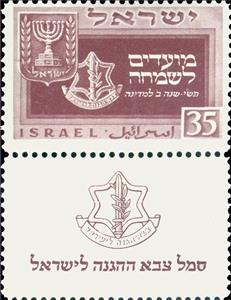Stamp with Collectible Margin: Coats of Arms Israel and Israeli Army Insignia (Israel 1949)
Coats of Arms Israel and Israeli Army Insignia (Israel 1949)
20 September (Israel ) within release Festival 1949 goes into circulation Stamp with Collectible Margin Coats of Arms Israel and Israeli Army Insignia face value 35 Israeli pruta
| Stamp with Collectible Margin Coats of Arms Israel and Israeli Army Insignia in catalogues | |
|---|---|
| Michel: | Mi: IL 21T |
| Stamp Number: | Sn: IL 30T |
| Yvert et Tellier: | Yt: IL 20T |
| Stanley Gibbons: | Sg: IL 20T |
Stamp with Collectible Margin is square format.
Jewish New Year, 5710: Arms and service insignia - ArmyAlso in the issue Festival 1949:
- Stamp with Collectible Margin - Coats of Arms Israel and Israeli Air Force Insignia face value 5;
- Stamp with Collectible Margin - Coats of Arms Israel and Israeli Army Insignia face value 35;
- Stamp with Collectible Margin - Coats of Arms Israel and Israeli Navy Insignia face value 10;
Stamp with Collectible Margin Coats of Arms Israel and Israeli Army Insignia it reflects the thematic directions:
A coat of arms is an heraldic visual design on an escutcheon (i.e. shield), surcoat, or tabard. The coat of arms on an escutcheon forms the central element of the full heraldic achievement which in its whole consists of shield, supporters, crest, and motto. A coat of arms is traditionally unique to an individual person, family (except in the United Kingdom), state, organisation or corporation.
A festival is an event celebrated by a community and centering on some characteristic aspect or aspects of that community and its religion or cultures. It is often marked as a local or national holiday, mela, or eid. A festival constitutes typical cases of glocalization, as well as the high culture-low culture interrelationship. Next to religion and folklore, a significant origin is agricultural. Food is such a vital resource that many festivals are associated with harvest time. Religious commemoration and thanksgiving for good harvests are blended in events that take place in autumn, such as Halloween in the northern hemisphere and Easter in the southern.
The New Year is the time or day at which a new calendar year begins and the calendar's year count increments by one. Many cultures celebrate the event in some manner. In the Gregorian calendar, the most widely used calendar system today, New Year occurs on January 1 (New Year's Day, preceded by New Year's Eve). This was also the first day of the year in the original Julian calendar and the Roman calendar (after 153 BC)



